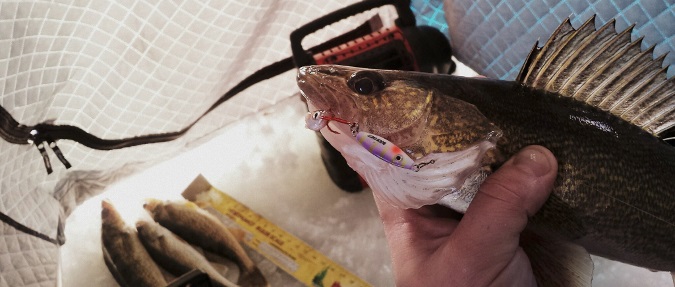
Tips for finding walleyes during the very productive “early ice” fishing season were offered in my last story. This writing will be a look at ways to catch the early season walleyes we located.
Arrive early and be quiet!
Early ice fishing trips often occur on a few inches of ice, and often that ice is clear and not completely snow-covered. Plus, lots of the good early ice walleye action often occurs in shallow to mid-depth waters. For those reasons, it is a good idea to get to your fishing spot early, get your equipment set up, and get fishing holes drilled well before you expect the good fishing action to start.
Often, the best winter bite occurs at dusk – say around 4:30 pm to 6:00 pm – and so I like to be all set up and ready by 4:00 pm to minimize the risk of spooking any early biters that show up. Also, being well organized with your gear so your movements can be limited when the fish are biting is another useful tip. Banging equipment on the ice and doing lots of moving around are good ways to spook early ice walleyes, so being set up and well organized will usually increase the number of walleyes that come top-side during this period!
Jig, jig, and jig!
Early ice walleyes are often still aggressive and can be “called in” and triggered to bite using aggressive jigging approaches. The 1/8-ounce Buck-Shot Rattle Spoon has put lots of early ice walleyes on the ice for me over the years. The thumping and clicking properties of this bait do an excellent job of calling in aggressive early season walleyes.
Last year, a fluttering version of the bait, called the Buck-Shot Flutter Spoon, was good for early season walleyes as well. This bait falls a bit slower and is ideal when the fish are a bit more tentative. The original Buck-Shots and the new fluttering versions come in UV colors for increased visibility. The UV glow perch and UV purple tiger patterns in the 1/8-ounce sizes work well for me when early season walleyes are my target.
See the action!
Getting set up early, being quiet, and using jigging spoons are great tips for early ice walleye fishing success. A final tip is to use a winter sonar unit if possible. Sonar units allow me to “see” bottom, my spoon, and any fish that approach it.
Being able to see these things is important because, it not only allows me to put my spoon in a fish’s face, it also enables me to match my jigging approach to the fish’s activity level. For example, some days aggressive lift and fall jigging tactics lead to bites. Other times, a longer pause at the end of the fall is important. While on other days, more subtle rocking-type jig motions work well. Whatever the case, being able to see the bait and how the fish respond to it is a great way to catch more walleyes.
I have been using Vexilar sonar units for most of my fishing career and am impressed with their quality and reliability. Plus, they are available in a variety of models to suit individual angling needs and desired price points. Regardless the winter sonar unit chosen, this is one piece of equipment I don’t leave home without when ice fishing!
Mike Frisch is a western Minnesota fishing guide and co-host of the popular Fishing the Midwest TV series. Visit www.fishingthemidwest.com or follow Fishing the Midwest on Facebook for more “fishy” stuff.
